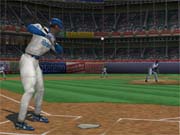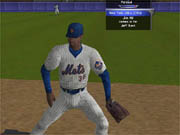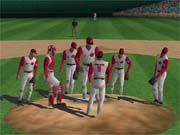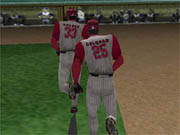High Heat Major League Baseball 2002 is the perfect example of what happens when a good game is released too soon. Thanks to a mad rush to get the game onto store shelves prior to Opening Day, 3DO has provided a baseball experience that has more bugs than a block of condemned houses. It is by turns both remarkably fulfilling and incredibly frustrating. Some aspects of the game will really impress you; others will make you want to throw your monitor out the window.

These flaws blemish nearly every aspect of this feature-rich game. Though you can still play in custom leagues over multiple seasons, a computer-controlled roster bug will cause crashes to the desktop. Seasons thus affected are unplayable until you manually edit some of the computer teams to add players back to their lineups. Though you can still log on to the Internet and challenge opponents across the country, lag is so atrocious that games rarely get beyond the opening scenes where players run onto the field. This is a problem both with dial-up and high-speed connections. Though you can still try to guide the Chicago Cubs to their first season of glory since 1908, you can't do it at legendary Wrigley Field because a pop-up bug frequently causes hard system lockups. Once that pop fly goes up, it stays up, forcing you to quit out of the program, terminating the game in progress. And so on, and so on.
Needless to say, this is extremely disappointing. Yet at the same time, all of these flaws somehow can't diminish the stark fact that the designers of High Heat 2002 know baseball better than anyone this side of Cooperstown. Gameplay remains captivating despite the bugs. Nothing gets in the way of enjoying the series' trademark: an uncannily realistic re-creation of the pitcher-batter confrontation that is at the heart of the national pastime. At-bats in High Heat 2002 play out exactly as they do in the real Major Leagues. When on the mound, you need to mix up your pitch selection, speed, and location. Fall into a predictable pattern and even the likes of Rey Ordonez will eat you for breakfast. Patience is required in the batter's box. Computer hurlers will mix up their pitches and keep you guessing. Swing at a lot of balls and you'll inflate some lucky pitcher's strike-out stats, not to mention lose a lot of ballgames. When combined, these two basic elements create a total experience that's as engaging as any sports game ever released to date, for any platform.

Other components of the game are similarly authentic. Computer managers manipulate their rosters with real acumen, pulling pitchers who aren't getting the job done, intentionally walking tough batters in key situations, calling for double switches where appropriate, and even making a lot of substitutions in the late innings of blowouts. They also play an aggressive brand of ball that leads to a lot of freewheeling on the basepaths; let up for a moment and you'll have enemy runners in scoring position. Mound visits and rain delays are new to the series this year. Sending your manager out to the mound can be extremely useful when you want to delay the game and give a reliever more time to warm up, while the pep talk can also energize a flagging pitcher. Rain adds atmosphere and a tactical element to gameplay, as pitchers sent back to the mound after a lengthy delay are more likely to hurt themselves. Injuries are actually a factor in all games that take place in or around the wet stuff, as position players are more likely to come up lame after a play on the slick field.
Stat generation in the game is also quite true to life, though there are some quirks in it. A simulation of the 2001 season saw expected contenders like the Boston Red Sox, New York Mets, and Texas Rangers make the playoffs, but also the emergence of expected also-rans. The Montreal Expos tied with the Colorado Rockies for the best record in the NL, each at 95-67, while the Milwaukee Brewers somehow won the NL Central with an abysmal 79-83 mark. The Red Sox went on to down the Rockies in the World Series. The senior circuit was also the home of some surprises in the individual stat categories. Jose Vidro won the batting crown with a .348 average, and Hideki Irabu sported an impressive 18-5 record that led the way for starting pitchers (though Randy Johnson stole the pitching award with a mediocre 14-11). Barry Bonds captured the home run crown with 51 dingers. Things were less dramatic in the American League, where Pedro Martinez ran away with top pitcher honors thanks to his 22-6, 2.25 season, and his new teammate, Manny Ramirez, took home the MVP trophy thanks in part to his league-leading .377 average.
Computer trading is marked by some extremely odd moves. Though most transactions are of the "Lance Berkman for Matt Stairs" variety, there are a number that stand out. The computer seems particularly prone to shipping out veterans for young unknowns with promise. For example, the Dodgers dumped Kevin Brown in the midst of a good season for 25-year-old second baseman Andre Powers, Cincinnati gave Pete Harnisch away for AA starter Don Rhodes, and Tampa Bay moved Fred McGriff for pitching prospect Rich Carey. Financial considerations in the real world make the above deals stand out perhaps more than they should, though it's hard to see Los Angeles getting rid of Brown for even a dozen blue chippers, big contract or not.

One of the biggest selling points of High Heat 2002 is a much-touted graphical overhaul. This long overdue renovation provides an attractive sheen to the game as a whole, yet is still patchy. Player-specific animations that depict the peculiar windups and batting stances of Kevin Brown and Tony Batista, among others, are a great touch of realism, but for every player that received this extra attention, dozens went untouched. Even some recognizable superstars were left alone. Larry Walker, for example, doesn't hunker down into his trademark crouch at the plate. The same goes for facial features. While some top ticket-sellers like Barry Bonds and Jeff Kent boast likenesses pretty close to what we can see during the Saturday game of the week, many others have generic faces that are pretty creepy when seen close up. The aforementioned Kevin Brown has been given a bizarre melted-looking visage that will remind more than one Dodger fan of the climactic scene in Raiders of the Lost Ark.
Batting animations remain a sore point. Although the player models are now much more detailed than in previous installments (thanks to doubling the polygon count), they continue to move in an awkward fashion. A few more frames of animation would have worked out a lot of the kinks. Bigger, more impressive stadiums convey the Big League atmosphere better than ever before, though even the new scaling and vertex lighting can't cover up textures that appear to date back to 1995. Some stadiums also display graphical glitches of one form or another. A wall in the Edison Field bullpen flashes distractingly, and the mound at historic Crosley Field in Cincinnati allows pitchers to throw while ankle-deep in dirt.
Audio improvements are afflicted with similar problems. Drowsy play-by-play man Ted Robinson has been replaced by a more dynamic two-man booth comprising Dave O'Brien and Ray Fosse, but the uninspired script remains nearly the same as in past years. While O'Brien may be more lively than his predecessor, there isn't much that even he can do with repetitive duds like "And now the closer gets up in the bullpen," and "New York...is up next." And even this part of the game isn't bug-free. Hecklers in the stand will occasionally go into a loop, forcing you to listen to the same crank repeat lines like "Looo-ser!" over and over again until the end of the game.

As outstanding as the core elements of High Heat Major League Baseball 2002 undoubtedly are, it's hard to emerge from an extended session of gameplay without some serious misgivings. For every dramatic at-bat that's so realistic you can almost smell the pine tar, there are a dozen disappointing reminders that the game simply hasn't been completed. Buyers of the product in its current form can't help but feel like unofficial, unpaid members of 3DO's quality assurance team.
But as offensive as that is--particularly coming on the heels of two previous High Heat games that also required significant patching--it's impossible to be too hard on a game that captures baseball so well. The designers understand the real sport's ebb and flow in a way that's never been equaled, making the latest installment of the game a must-buy for baseball fans, bugs or not. So, while they got enough right to overshadow the many bugs and make waiting for the inevitable patch not quite so onerous, next year, the designers might want to spend a little more time in spring training before starting the regular season.